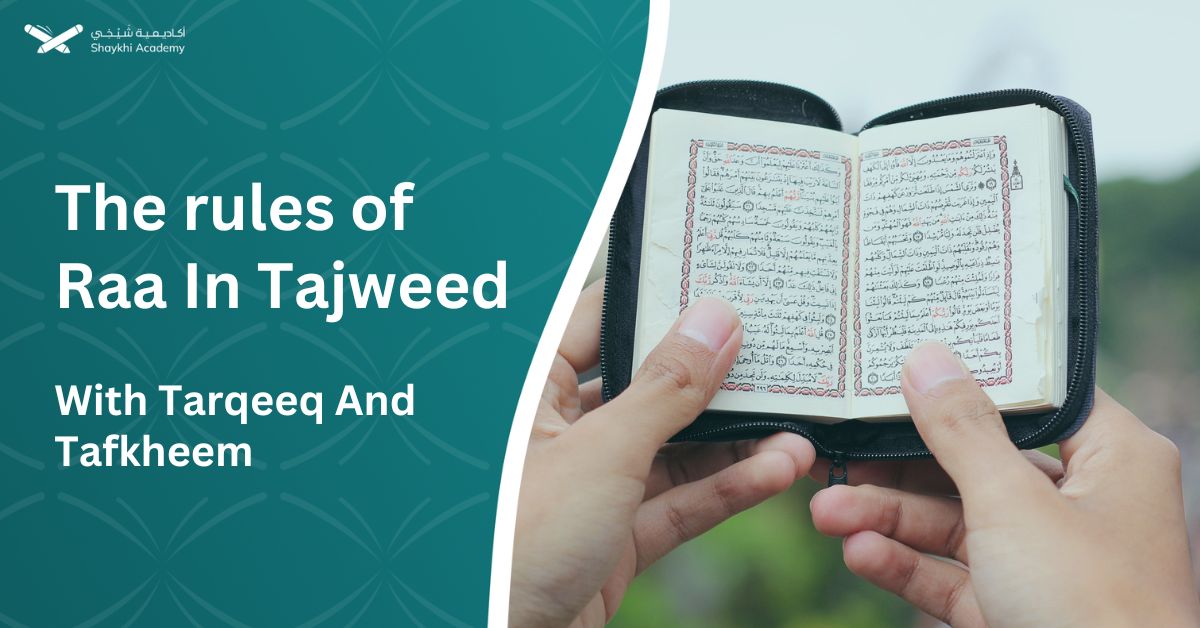The rules of Raa in Tajweed dictate how to pronounce the Arabic letter “Raa” accurately in Quranic recitation. They cover when to emphasize (Tafkheem) or lighten (Tarqeeq) the sound of Raa based on its surrounding vowels and consonants. Following these rules ensures clear and authentic Quranic recitation.
One of the most significant letters in Tajweed, which consists of the guidelines for pronouncing the Holy Qur’an correctly, is Raa (ر). For accurate recitation and comprehension of the Quran, it is imperative to pronounce the letter “Raa” correctly.
Rules of Raa In Tajweed
The rules of Raa in Tajweed are crucial guidelines governing the pronunciation of the Arabic letter “Raa” in Quranic recitation. These rules are diverse, ranging from the necessity of “Tafkheem” (emphasizing) in certain contexts to the requirement of “Tarqeeq” (lightening) in others, or the permissibility of both.
There are three main conditions for Raa:
- Tafkheem (Emphasizing Raa): This occurs in various situations, including when Raa is followed by a closed vowel, an open vowel, a consonant after a “Damma” or “Fatha,” or after a broken Kasrah followed by a letter of elevation. Raa is also emphasized when preceded by a consonant other than “Yaa” with a preceding vowel of Damma or Fatha.
- Tarqeeq (Lightening Raa): This occurs when Raa is followed by a broken Kasrah, either directly or separated from it. Tarqeeq also happens when Raa is followed by a consonant after a Sukoon, a silent “Yaa,” or a broken Kasrah.
- Permissibility of Both: In certain cases, both emphasizing and lightening Raa are allowed. For instance, when Raa is followed by a broken vowel and is silent in pronunciation or followed by a silent “Yaa” and followed by a broken Kasrah.
Overall, the rules of Tafkheem and Tarqeeq ensure accurate pronunciation and recitation of the Quran, enhancing the beauty and authenticity of the recitation.
When reciting the Quran, it is imperative to adhere to the norms of Raa rules tajweed for accurate pronunciation. These guidelines aid in guaranteeing that the letter Raa is pronounced clearly and accurately.
How do we pronounce the letter Raa in Quran
Here are some rules of Raa in Tajweed important guidelines to remember:
1. Rules of raa tafkheem:
Here you may ask when is Raa heavy? The letter Raa (ر) is spoken with a heavy voice when it has a Harakah (diacritic) on top, like Fatha or Damma. This indicates a stronger stress and intensity in the Raa sound’s pronunciation.
2. Light Raa (Raa’s Tarqeeq):
The letter Raa (ر) is pronounced lightly when it has a Harakah (diacritic) underneath it, like in Kasrah.
This indicates that there is less stress and intensity while pronouncing the Raa sound.
3. Tarqeeq’s Priority:
Tarqeeq is preferred for pronouncing the letter Raa, however, Tafkheem is also acceptable in some situations. This indicates that the light sound of the Raa is preferred whether given the option to pronounce it that way or heavy.
4. Tafkheem’s Top Priority:
There is one exception, though, when Tafkheem is granted precedence. There is just one instance of this in the Quran, where the Raa is pronounced heavily while having a Harakah underneath it.
Raa Saakin examples
Examples of tafkheem and tarqeeq of raa or Raa saakin and raa mushaddad examples:
Tafkheem of Raa Examples
The proper articulation and pronunciation of the letter Raa are referred to as the Tarqeeq of Raa in Tajweed. It is noteworthy that, depending on the circumstances, the Tarqeeq of Raa can also be pronounced with Tafkheem. Here are a few instances of Raa’s Tarqeeq in Tajweed:
- Fatha, the Tafkheem of Raa with the Short Vowel
Take the term “مُّطَهَّرَة” (muthahhara), for instance, where a Fatha comes before a Raa.
- Raa’s Tafkheem with Sukoon following Fat-ha
For instance, the Raa comes first and is preceded by a fat-ha in the word “الأَرْض” (al-ardh).
- Raa’s Tafkheem with Sukoon following the Sakin Letter and Fat-ha
An instance would be “عَــــشْـــرٍ” (ashrin), in which the Raa is succeeded by sukoon, preceded by a fat-ha and the sakin letter “shin.”
- Dammah, the Short Vowel Tafkheem of Raa
For instance, in the phrase “وَزُخْرُفَــــــا” (wazukhrufa), a Dammah comes after the Raa.
- Raa’s Tafkheem with Sukoon following Dammah
For instance, in the phrase “الْـقُـرْءَانُ” (al-Qur’an), Raa comes first and is preceded by Dammah.
- Tafkheem of Raa with Sukoon following the Dammah and Sakin Letter
One example is “الْعُــــسْـر” (al-‘usr), where the Raa is replaced by sukoon, which comes before the sakin letter “sin,” which comes before Dammah.
- Raa’s Tafkheem with Sukoon following Hamzatul-Wasl
For instance, in the phrase “ارْحَمْهُمَـا” (arhamhuma), Hamzatul-Wasl comes before the Raa and sukoon comes after it.
- Some Letters’ Tafkheem
Lastly, Tafkheem is always used while pronouncing the five terms that were previously mentioned: رْ, صَ, قَ, and طَ. “فِرقَة” (firqah) is one word that exemplifies this.
Tarqeeq of Raa Examples
In some contexts, the term “Tarqeeq” describes how the letter “Raa” is spoken lightly. The Tarqeeq of Raa in Tajweed has the following key guidelines and examples:
- Raa’s Tarqeeq when Raa arrives with Kasrah
For instance, the word “رِزْقًا” (rizqan) is pronounced with tarqeeq when the Raa is followed by a kasrah.
- Raa’s Tarqeeq when it comes before a letter with Kasrah and after a Sukoon
This may be seen in the word “وَاسْتَغْفِرْه” (wastaghfirhu), where the Raa is preceded by the letter “fa” with kasrah and has a sukoon.
- The Raa’s Tarqeeq when it precedes Yaa Sakinah and is accompanied by Sukoon
For instance, in the phrase “الْخَـيْرِ” (al-khayri), the Yaa Sakinah comes before the Raa, who possesses a sukoon.
- Tarqeeq of Raa when Raa precedes Sukoon and arrives with it
In the word “حِجْــــرٍ” (hijrin), the Raa has a sukoon and is preceded by the sakin letter “jeem,” which is preceded by the letter “ha” with kasrah. This is an illustration of the rule in action.
- Tarqeeq has precedence over Tafkheem in this situation
Tafkheem and tarqeeq are permitted in the Quran for just five terms, yet tarqeeq is recommended. The terms in question include:
- “فِرْقٍ” (firqin)
- “فَأَسْرِ” (faasri)
- “يَسْرِ” (yasri)
- “وَنُذُرِ” (wanudhuri)
- “الْقِطْرِ” (al-qitr)
You can now learn the rules of the Raa from A to Z with the Shaykhi Academy courses, register now.
Conclusion:
In Tajweed, the rules governing the pronunciation of the Arabic letter “Raa” are essential for accurate Quranic recitation. These rules encompass various scenarios, including the necessity of “Tafkheem” (emphasizing) and “Tarqeeq” (lightening) of Raa, as well as instances where both are permissible.
Tafkheem occurs when Raa is followed by a closed or open vowel, a consonant after a Damma or Fatha, or other specific conditions. Conversely, Tarqeeq is applied when Raa is followed by a broken Kasrah or specific consonants.
Mastering these rules ensures clear and accurate pronunciation of Raa in Quranic recitation, enhancing the beauty and authenticity of the recitation. Enrolling in courses like those offered by Shaykhi Academy can provide comprehensive learning opportunities to understand and apply these rules effectively.















































